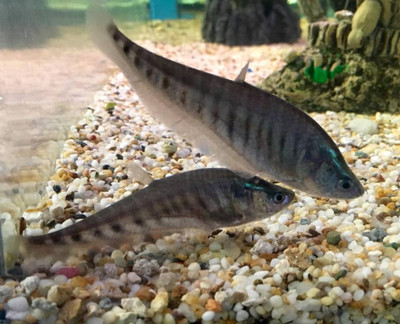Clown Knifefish
Posted by Max Gandara on on 19th Feb 2025
The Enigmatic Clown Knifefish: A Fascinating Aquarium Inhabitant
The Clown Knifefish, with its unique appearance and captivating behavior, is a remarkable species that has intrigued fish enthusiasts and aquarists alike. Native to Southeast Asia, particularly in Thailand, Laos, Cambodia, and Vietnam, this freshwater fish has become a popular addition to many home aquariums around the world. In this blog, we'll delve into the fascinating world of the Clown Knifefish, exploring its characteristics, habitat requirements, and care tips for potential keepers.
Characteristics of the Clown Knifefish
The Clown Knifefish, scientifically known as Chitala ornata, is easily recognizable due to its distinctive body shape and pattern. Here are some key features:
-
Appearance: The fish boasts an elongated, laterally compressed body with a knife-like shape, earning its name. Its silver body is adorned with dark, eye-catching spots that resemble a clown's makeup, hence the name "Clown Knifefish."
-
Size: This species can grow quite large, reaching up to 3 feet (about 90 cm) in the wild. In captivity, they typically grow to around 2 feet (60 cm), depending on the size of their enclosure.
-
Behavior: Known for their nocturnal nature, Clown Knifefish are most active during the night. They are generally solitary creatures and can be aggressive towards other fish if not provided with enough space.
Habitat and Aquarium Requirements
To ensure the health and well-being of a Clown Knifefish, it's essential to recreate a suitable environment in the aquarium that mimics their natural habitat:
-
Tank Size: Given their potential size, a large tank of at least 100 gallons (about 380 liters) is recommended for a single adult Clown Knifefish. A larger tank is necessary if you plan to keep more than one.
-
Water Conditions: The water should be maintained at a temperature between 75°F and 82°F (24°C to 28°C) with a pH level of 6.5 to 7.5. A strong filtration system is crucial to keep the water clean and well-oxygenated.
-
Decor and Substrate: The tank should be decorated with plenty of hiding spots, such as rocks and driftwood, to provide the fish with security during the day. A sandy substrate is ideal to emulate their natural riverbed environment.
-
Lighting: Since Clown Knifefish are nocturnal, subdued lighting is preferable, especially during daylight hours.
Feeding and Diet
The Clown Knifefish is a carnivorous species that thrives on a diet rich in protein. Here are some dietary considerations:
-
Diet: In the wild, they feed on small fish, insects, and crustaceans. In captivity, they can be fed a variety of foods including live or frozen fish, shrimp, and high-quality pellets designed for carnivorous fish.
-
Feeding Schedule: It's best to feed them in the evening or at night to align with their natural feeding habits, providing enough food but avoiding overfeeding to maintain water quality.
Challenges and Considerations
While Clown Knifefish can be a stunning and rewarding species to keep, there are several challenges to consider:
-
Size and Space: Their large size and territorial nature mean they require ample space and may not be suitable for all aquarists.
-
Compatibility: Care should be taken when selecting tank mates, as Clown Knifefish can be aggressive and may prey on smaller fish.
-
Lifespan: These fish have a long lifespan, often living up to 10 years or more in captivity, which requires a long-term commitment from their keepers.
Conclusion
The Clown Knifefish is undoubtedly a mesmerizing addition to any aquarium, offering beauty and intrigue with its distinctive appearance and behaviors. For those willing to meet their specific care requirements, these fish can become the centerpiece of a fascinating aquatic display. With the right environment and attention, Clown Knifefish can thrive and delight aquarists for years to come.

